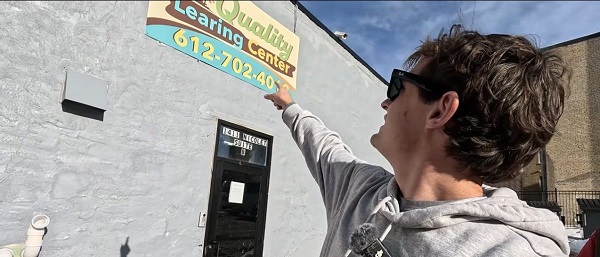 You want my idea for the wage subsidy… well here it is.
You want my idea for the wage subsidy… well here it is.
WARNING: It is so simple to implement, there is no way a government would do it.

 You want my idea for the wage subsidy… well here it is.
You want my idea for the wage subsidy… well here it is.
WARNING: It is so simple to implement, there is no way a government would do it.
People have said “you are quick to pick apart the wage subsidy, so what is your solution?”
So… you asked for it… here it is:
I’ve said it from the very beginning that it should resemble EI support. All they should be doing is simple.
(No this is not an April Fool’s joke… but I am hoping the Press Conference on April 1, 2020 by the Minister of Finance was)
I was fine with EI amounts… but since we have the Canadian Emergency Response Benefit (CERB)… let’s use that amount to keep it more simple.
The amount is this:
(just like the CERB). $2,000 per worker per month, taxable, and no withholdings up front
Put a ‘clawback’ amount on those that are getting it like the clawback on Old Age Security or regular EI benefits for when they file income tax next year.
The 3-prong approach to the subsidy
Prong 1 – CERB from Service Canada
Everyone should get it. Yes, everyone.
However, anyone that makes more than the EI maximum in 2020 must pay back 30 cents of the CERB on every dollar over the $54,200 EI maximum threshold when they file their 2020 taxes.
So when you file your personal 2020 income tax, if you ended up making more than $80,667 in income, you will have had to pay back the full $8,000 of CERB received on a T4E.
This results in helping everyone today, help jump start the economy when we need to and have those that get back on their feet quicker, paying some or all of it back.
If you received both the CERB from Service Canada, and the CERB through your employer, you have to pay back the amount greater than the $8,000 received, and then any other amount based on the formula above.
This will prevent or reduce the double dip.
Prong 2 – CERB through the Small Business employer
The small business (less than $15M in assets of all associated corporations) employer would also get the CERB on a per-employee basis. They already have to fill out the number of employees when they file their remittance forms, so what’s the difference?
This $2,000 flows through to subsidize the wages, and must be paid to the employees. You create a different box number to track it on the T4 slips next year for audit purposes and to make sure the employee got the money.
I know this isn’t 75%, but the 75% was a capped amount anyways. That’s why I said keep it simple.
In order to incentivize the small business employer so they don’t lay them off, treat it as a flow through, and non-taxable to the employer.
So if there are five employees at the small business, the employer will get $10,000 of CERB to flow through to the employees.
The employee’s wages will be subsidized by the $2,000 amount, and they will put the $2,000 in a different box on each T4 slip for tracking purposes.
In order to incentivize the employer to act as the flow-through for Service Canada, this $2,000 will not be subject to EI or CPP by the employer and will not be included in the taxable income of the employer.
This allows the employer to claim the full wage deduction, have subsidized payroll costs, and save the income tax amount by deducting the full payroll.
By not counting it as income, this tax and remittance savings can be viewed liked an “admin fee” for acting on Service Canada’s behalf.
On $10,000 (5 employees) this would save up to $252 in Employer EI, $525 in Employer CPP, and $900 in federal income tax.
Cost to government for employer being the administrator instead of Service Canada: $1,167.
Incentive for employer to NOT lay off the staff, $10,000 in wage costs… and $1,167 in tax savings.
Prong 3 – CERB through Large Corporations
If the employer is getting the CERB on a per-employee basis and they are a large (greater than $15M in assets) corporation or associated group, allow them to not pay employer EI or CPP on the CERB.
100 employees = $200,000 = up to $5,040 in reduced EI, and $10,500 in reduced CPP remittances as the incentive.
So the employer gets $2,000 per employee as a subsidy to cover wage costs, and does not have to do payroll withholdings on the amount, saving them a total of $200,000 + 5,040 + 10,500 = $215,540.
Or put another way, they can save $15,540 by not laying them off.
If that’s not enough incentive, then perhaps look at it being only 50% taxable, which in the example above, would reduce Federal income tax by $15,000 (using 15% general rate x 50% x $200,000)
Audit Tracing
By simplifying the process, there is less ability for abuse.
Service Canada will issue everyone a T4E with the CERB they personally received from them (no application necessary).
T4 box numbers can be reconciled by CRA on slip filing to amounts of CERB received by the employer through the PIER system.
Those same boxes can be reconciled to specific individuals on tax filings to see if there were any that should repay.
Amounts greater than $8,000 received by anyone will need to be repaid.
Those with income over the EI Maximum amount, will have to repay some or all of the CERB back when they file.
If you don’t agree… well… the specific repayment formula can be figured out later… we have a year for that. We need the money in the public’s hands now though.
In Conclusion
These incentives and recapture mechanisms will reduce the likelihood of layoffs in low-margin industries like hospitality since $2,000 a month goes a long way to covering those wages; it will “Flatten the EI Curve” (trademark pending – not really… but I like saying it)
It would get everyone back working quicker after this is done by maintaining the connection to employers, and get the economy kick-started with cash injections at the front of this thing, rather than the end.
In the end… you have employers flowing the $2,000 through to the employee on Service Canada’s behalf as a no-withholding amount and a nominal cost to the employer to administer it, rather than Service Canada processing hundreds of thousands (if not millions) of individual applications.
If they are a small business, they actually get a tax savings by being the administrator and helping Service Canada in the process.
If they are a large business, they can have a good chunk of payroll costs reduced by not having to pay EI and CPP on the amount, and perhaps tax savings.
In the end, every worker gets $8,000 over 4 months just to buy everyone time and we have Flattened the EI Curve.™
Biography of Cory G. Litzenberger, CPA, CMA, CFP, C.Mgr can be found here.

Here’s some news from Spanish researchers: contrary to what American health bureaucrats said for years to justify the increasingly insane mRNA “vaccine” experiment, Covid doesn’t kill kids.
—
(More facts, fewer guesses. For pennies a day.)
—
Yes, making categorical statements like “Covid doesn’t kill kids” is foolish.
Look hard enough, and there will be an exception, perhaps a child terminally ill with cancer pushed over the edge by Covid.
But the Spanish study, which was peer-reviewed and published in The Pediatric Infectious Disease Journal, proves yet again that Covid’s risk is too low to measure — not just not to healthy children, but to all children. It is the strongest evidence yet that the oft-repeated claim that Covid has killed 2,100 American children is fiction.¹
The researchers examined medical records from 2.7 million Spanish children and teenagers from mid-2021 through the end of 2022, a period in which the Omicron variant infected almost everyone worldwide with Covid. The vast majority of those kids and adolescents, about 2.2 million, had not been vaccinated.
Yet none of those 2.7 million died of Covid.
None. As in zero.
—
(Good thing we closed the schools!)
(SOURCE)
—
There really isn’t much more to say about the paper, except that the authors couldn’t find any difference for Covid hospitalization rates between vaccinated and unvaccinated kids under 12.
For adolescents 12-17, they calculated about 38,000 mRNA jabs were required to avoid one Covid hospitalization — an absurdly high number given the known short-term side effects of the shots and the potential long-term risks of exposing young people to mRNA.
At this point, any physician who recommends Covid jabs for kids (as a handful, mostly in blue states, still are) should be sued for malpractice.
—
One final note: this week’s immigration articles have gotten a LOT of likes and comments, more than any recent Covid or mRNA pieces. More new subscribers too.
I expect that will be true again today, though I hope you’ll prove me wrong. I understand. We all have moved on.
But when studies like this new one come out, covering them is crucial.
Nearly 1.5 billion people received mRNA Covid jabs worldwide, including perhaps 100 million kids and teenagers in the United States, Canada, Japan, Europe, and elsewhere. And the American public health establishment and legacy media outlets continue to push mRNA on children and fight even modest efforts to tighten restrictions on mRNA Covid jabs.
Witness the furious pushback Food and Drug Administration chief medical officer Dr. Vinay Prasad received in late November after he reported FDA reviewers found Covid shots had killed children.
So, even as I write about immigration, healthcare fraud, and other topics vital to you, I believe I have a duty to continue to update the factual record about the mRNAs. Duty is not too strong a word. In June 2023, I covered a paper from South Korean researchers about cardiac deaths of young adults who had received the mRNA jabs.
It is no exaggeration to say no one else — no other journalist or scientist covering Covid or the jabs — paid attention to that paper at the time . But now, in the wake of Prasad’s bombshell memo, I’ve again raised that paper. Even the mRNA fanatics at the Atlantic have been forced to acknowledge it.
It’s impossible to know if these articles will matter today, tomorrow, or years from now. But as long as the mRNA companies and their public health handmaidens keep pushing this troubled technology, I’ll keep trying to build the most complete possible record.
—
(And I hope you will support me.)
(More facts, fewer guesses. For pennies a day.)
That 2,100 death figure, which the American Academy of Pediatrics loves to quote, appears to come from a 2023 paper from the National Academy of Medicine paper that in turn relies on Centers for Disease Control data. But the CDC figures no distinction between “with” and “from” Covid deaths, which are particularly important in groups at low baseline risk from Covid. Further, the fact that the number hasn’t been updated in almost three years suggests that the people quoting it know it’s nonsense and don’t want to double-check it, much less try to update it.
What, kids just stopped dying from Covid in 2023 after getting mowed down during the first three years of the epidemic?
|
|||
|
|||||
|
|||||
| Independent, citizen-funded journalism |

A Canadian judge has dismissed a demand from Canadian government lawyers to seize Freedom Convoy leader Chris Barber’s “Big Red” semi-truck.
On Friday, Ontario Court of Justice Judge Heather Perkins-McVey denied the Crown’s application seeking to forfeit Barber’s truck.
She ruled that the court is already “satisfied” with Barber’s sentence and taking away his very livelihood would be “disproportionate.”
“This truck is my livelihood,” said Barber in a press release sent to LifeSiteNews.
“Trying to permanently seize it for peacefully protesting was wrong, and I’m relieved the court refused to allow that to happen,” he added.
Criminal defense lawyer Marwa Racha Younes was welcoming of the ruling as well, stating, “We find it was the right decision in the circumstances and are happy with the outcome.”
John Carpay, president of the Justice Centre for Constitutional Freedoms (JCCF), said the decision is “good news for all Canadians who cherish their Charter freedom to assemble peacefully.”
READ: Freedom Convoy protester appeals after judge dismissed challenge to frozen bank accounts
“Asset forfeiture is an extraordinary power, and it must not be used to punish Canadians for participating in peaceful protest,” he added in the press release.
As reported recently by LifeSiteNews, the Canadian government claimed that Barber’s truck is an “offence-related property” relating to his involvement in the 2022 protests against Canada’s COVID mandates.
At this time, the court ruling ends any forfeiture proceedings for the time being, however Barber will continue to try and appeal his criminal conviction and house arrest sentence.
Barber’s truck, a 2004 Kenworth long-haul he uses for business, was a focal point in the 2022 protests. He drove it to Ottawa, where it was parked for an extended period of time, but he complied when officials asked him to move it.
On October 7, 2025, after a long trial, Ontario Court Justice Perkins-McVey sentenced Barber and Tamara Lich, the other Freedom Convoy leader, to 18 months’ house arrest. They had been declared guilty of mischief for their roles as leaders of the 2022 protest against COVID mandates, and as social media influencers.
Lich and Barber have filed appeals of their own against their house arrest sentences, arguing that the trial judge did not correctly apply the law on their mischief charges.
Government lawyers for the Crown have filed an appeal of the acquittals of Lich and Barber on intimidation charges.
The pair’s convictions came after a nearly two-year trial despite the nonviolent nature of the popular movement.


“Captured and flown out”: Trump announces dramatic capture of Maduro


Trump Says U.S. Strike Captured Nicolás Maduro and Wife Cilia Flores; Bondi Says Couple Possessed Machine Guns


The U.S. Just Removed a Dictator and Canada is Collateral Damage


US Justice Department Accusing Maduro’s Inner Circle of a Narco-State Conspiracy


Vacant Somali Daycares In Viral Videos Are Also Linked To $300 Million ‘Feeding Our Future’ Fraud


Trying to Defend Maduro’s Legitimacy


U.S. Claims Western Hemispheric Domination, Denies Russia Security Interests On Its Own Border


Trump Says US Going To Run Venezuela After Nabbing Maduro